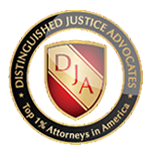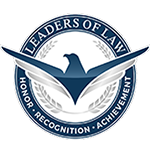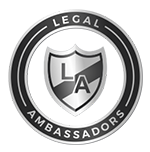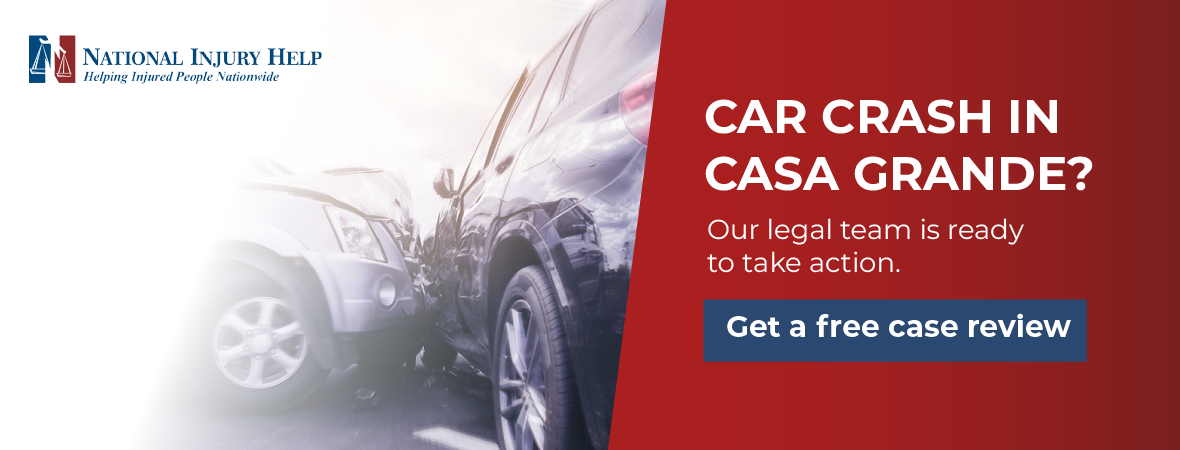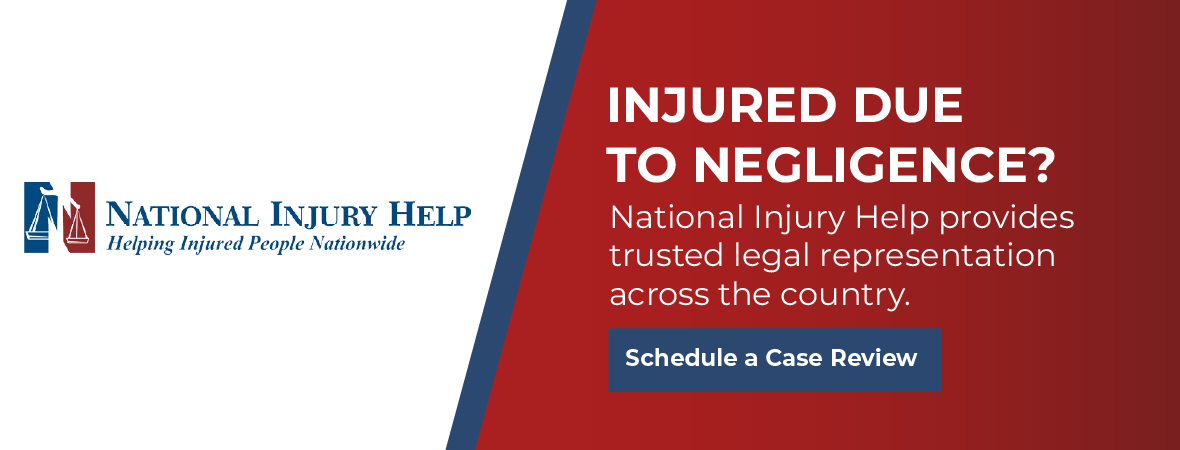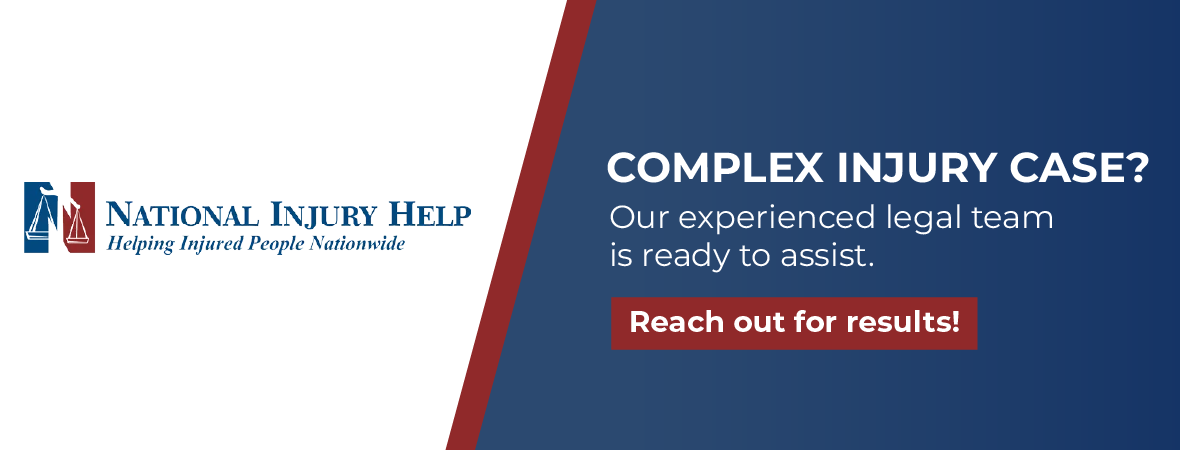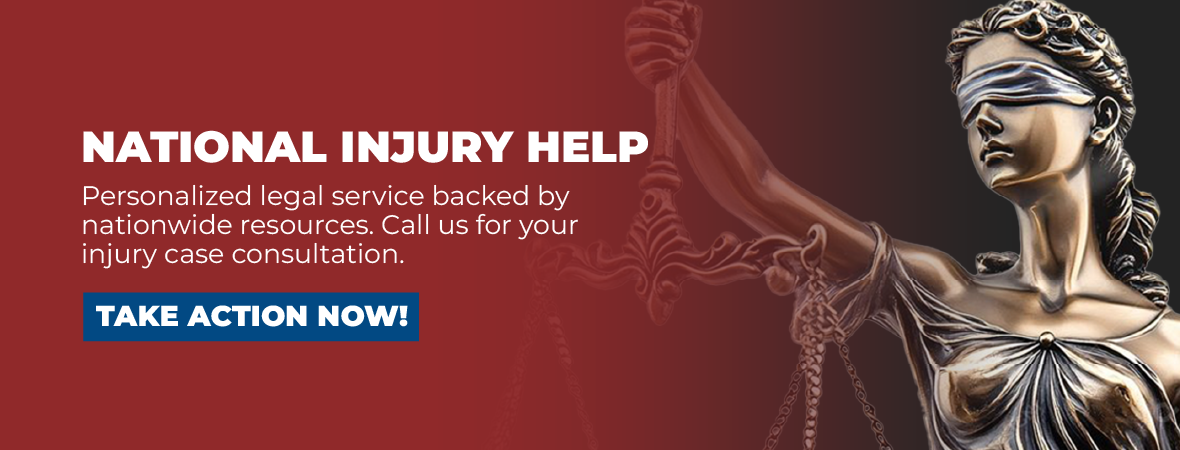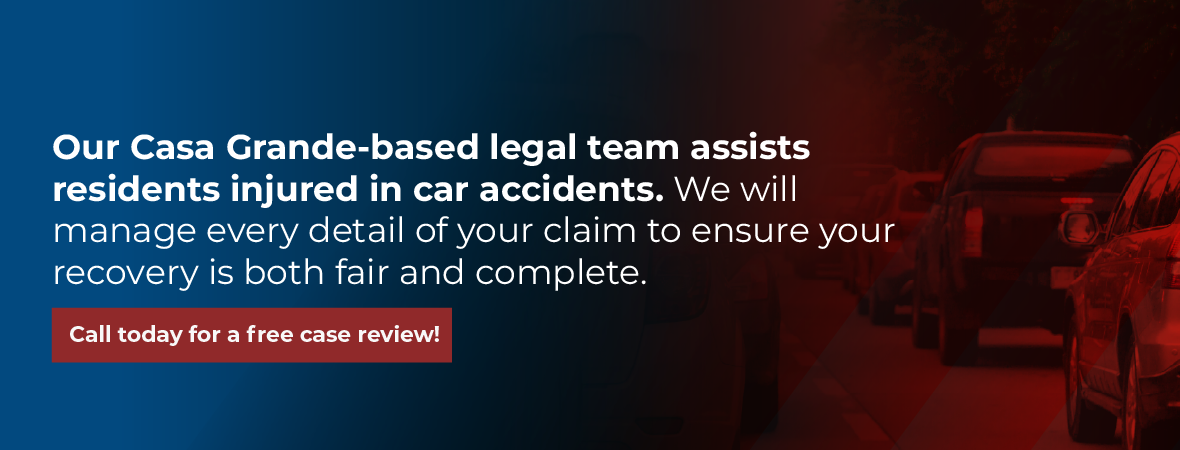A car accident in Casa Grande can leave you with injuries, medical bills, and insurance stress. Contact National Injury Help today by calling 1 (800) 214-1010. We are here to protect your rights and handle the legal details while you focus on healing.
Casa Grande sits at the busy crossroads of Arizona. Interstate 10 carries commuters between Phoenix and Tucson. Florence Boulevard, Highway 84, and State Route 387 link local neighborhoods to shopping centers, schools, and farms. Those same corridors also rank among the county’s most common crash sites. Speed, distraction, construction zones, and sudden dust storms all work against safe driving. When two sets of taillights meet unexpectedly, injuries follow.
If this happened to you, the very first step is to focus on healing. The legal side can feel like a maze, but you do not have to walk it alone. A Casa Grande-based car accident lawyer from National Injury Help can guide you through every rule, every form, and every call with the insurance company. You can rest and recover while we run down witnesses, read the police report, and push for the money you need.
Throughout this article, we explain the most common crash causes in Casa Grande, the steps to take after a collision, the basics of Arizona car accident law, and the ways we fight for fair compensation. By the end, you will know your rights, understand your options, and see exactly how we can take the burden off your shoulders.
Common Causes of Car Accidents in Casa Grande
If you’re filing a claim, identifying the cause of the accident plays a key role in proving who was at fault. The more clearly you understand what led to the crash, the better your chance of recovering compensation for your injuries, vehicle damage, and lost income.
Here are the most common causes of car accidents in Casa Grande.
Distracted Driving
Distracted driving is one of the leading causes of car accidents in Casa Grande and across the country. A few seconds of lost focus is all it takes to cause a life-changing collision.
Texting While Driving
Texting is especially dangerous. When a driver reads or sends a text, their eyes are off the road for about five seconds. At 55 miles per hour, that’s enough time to cover the length of a football field without looking. During that time, anything can happen: a child could cross the street, a car could stop suddenly, or traffic could shift.
GPS Use
Many drivers rely on GPS to get around, but scrolling through directions or trying to enter an address while driving is risky. It only takes a second to miss a stop sign, rear-end the car in front, or drift into another lane while trying to read a map.
Talking to Passengers
Even talking to others in the car can be distracting. If a conversation becomes too lively or emotional, drivers may stop paying full attention to what’s happening around them. They might miss important audio cues like horns, sirens, or screeching brakes.
Speeding and Reckless Driving
Speed limits exist for a reason. The faster a car is going, the less time the driver has to react, and the more damage that car will do in a crash.
Interstate 10
Casa Grande sits right along Interstate 10, a wide-open freeway that often tempts drivers to go well above the posted speed limit. Unfortunately, when traffic slows suddenly, speeding drivers may not have enough time to brake safely, leading to multi-vehicle pileups or high-speed rear-end crashes.
Highway 84
Highway 84 adds its own risks. The combination of curves, narrow lanes, and slow-moving farm equipment creates the perfect setup for an accident. When a fast-moving car comes around a bend and suddenly finds a tractor or utility vehicle in its path, the result can be a serious and even fatal collision.
DUI and Drug-Impaired Driving
Driving under the influence of alcohol or drugs continues to be a major problem in Casa Grande. Impaired drivers are slower to react, more likely to make poor decisions, and far more likely to cause devastating accidents.
Alcohol Impairment
Weekend nights, especially after local bars close, often bring a spike in DUI-related crashes. Drunk drivers may weave between lanes, run red lights, or drive the wrong way down one-way streets. These behaviors are especially dangerous on highways and rural roads with limited lighting.
Prescription and Over-the-Counter Medications
It’s not just alcohol. Prescription medications can also impair driving. Many drugs, even legal ones, cause drowsiness, confusion, or delayed reflexes. Labels often warn users not to operate heavy machinery, but these warnings are often ignored. That can lead to accidents that are just as serious as those caused by alcohol.
Failing to Yield and Running Red Lights
Some of the worst accidents happen when drivers ignore traffic signals or fail to yield properly.
Running Red Lights
Busy intersections in Casa Grande, such as Florence Boulevard and Trekell Road, are frequent sites of red-light crashes. A driver in a rush may try to beat the yellow light, but cross-traffic is already moving when they enter the intersection. These crashes often result in T-bone impacts, which are especially dangerous for passengers sitting on the side of the impact.
Failing to Yield on Left Turns
Left-turn accidents are also common. When drivers misjudge the speed or distance of oncoming traffic, they may attempt to turn across multiple lanes too quickly. The result is often a direct collision, and the turning driver is usually found at fault.
Poor Road Conditions and Construction Zones
Sometimes, the road itself contributes to accidents. Casa Grande has a mix of rural roads, older infrastructure, and active construction zones, all of which add risks for drivers.
Dust Storms and Visibility Issues
Sudden dust storms are a regular threat in the area. These storms can drop visibility to near zero in just seconds. Drivers who do not pull over or slow down quickly enough can find themselves in pileups or rear-end crashes.
Poor Lighting on Rural Roads
Many of Casa Grande’s outskirts lack adequate lighting. Driving at night can be hazardous, especially when debris, potholes, or animals enter the roadway unexpectedly. If a driver swerves to avoid an object or simply cannot see it in time, a crash may follow.
Construction Hazards
Construction zones require extra caution. Narrow lanes, abrupt lane changes, uneven pavement, and confusing signage can all lead to confusion and crashes. Drivers who are not paying attention or who ignore reduced speed signs are more likely to hit cones, barriers, or other vehicles.
What to Do After a Car Accident in Casa Grande
No one expects to be in a car crash, but when it happens, knowing what to do next can make all the difference. The steps you take in the minutes, hours, and even days following a car accident affect more than just your immediate safety; they also protect your right to fair compensation for injuries, vehicle damage, and other losses.
If you live in Casa Grande or were involved in a crash while traveling through the area, here’s what to do.
1. Move to Safety and Call 911
Your safety and the safety of others should always come first. If your vehicle is still drivable and you’re not seriously hurt, move it to the side of the road or a nearby parking lot to avoid blocking traffic and reduce the risk of a second collision. Turn on your hazard lights to alert other drivers.
If anyone appears injured, whether it’s you, a passenger, or someone in another vehicle, call 911 right away. Let emergency services evaluate the situation. If you or anyone else is bleeding heavily, feeling lightheaded, or unable to move, do not attempt to walk or exit the vehicle on your own. Wait for paramedics to assist.
In the moments after an accident, staying calm helps everyone. Take deep breaths, check on those around you, and follow the 911 operator’s instructions carefully.
2. Get Medical Treatment as Soon as Possible
Some injuries are obvious right away, like broken bones or open wounds. Others, like concussions, whiplash, or internal bleeding, may take hours or even days to show symptoms. That’s why it’s so important to get a medical evaluation, even if you think you’re “just a little sore.”
In Casa Grande, Banner Casa Grande Medical Center offers emergency services, and there are several urgent care clinics available if your injuries seem less serious. Wherever you go, be sure to tell the doctor that you were in a car accident. This helps link your injuries to the crash in your medical records, which is important for any claim you may file later.
Skipping this step can hurt your case. Insurance companies may argue that you were not really hurt if you waited too long to see a doctor. Early treatment is not only better for your health, it also strengthens your legal position.
3. Document the Scene Before It Changes
Accident scenes do not stay the same for long. Once the cars are towed, the debris is cleared, and the sun goes down, valuable evidence may be lost. That’s why it’s crucial to gather as much information as you can while you’re still at the scene, if you are physically able to do so.
Use your phone to take clear photos of:
- All vehicles involved, from multiple angles
- Damage to bumpers, windows, and side panels
- Skid marks, shattered glass, and vehicle debris
- Road signs, stoplights, and traffic conditions
- Weather and lighting conditions at the time
Also, information should be exchanged with the other driver(s). Write down or photograph:
- Full name and contact information
- Driver’s license number
- License plate number
- Insurance company and policy number
- Make and model of each vehicle
If there are any witnesses, ask for their names and phone numbers. Their perspective could be valuable later, especially if there is a dispute about what happened.
4. File a Police Report
An official police report is one of the most powerful documents you can have after a car accident. It provides a neutral third-party account of the crash, which helps support your version of events.
If possible, call the Casa Grande Police Department from the scene. When officers arrive, they will speak with all drivers, assess the situation, take notes, and create a formal accident report.
If the police are unable to respond, for example, in minor fender-benders where no one is seriously hurt, you should still file a report. Visit the police station within 24 hours to report the incident. Bring your notes, photos, and insurance information with you.
This report becomes part of the evidence your lawyer and insurer will use to determine fault and negotiate a fair settlement.
5. Avoid Giving Statements to Insurance Companies Without Legal Advice
Once the crash is reported to the insurance companies, an adjuster will likely contact you to get your version of what happened. They may sound polite or even friendly, but remember, their job is to protect the insurance company’s profits, not your well-being.
Do not give a recorded statement without speaking to a personal injury attorney first. What you say, even casually, can be used against you later. For example, saying “I’m fine” or “It was my fault” could be twisted to suggest that your injuries are minor or that you are responsible for the crash.
Instead, refer all insurance company communication to your attorney. A lawyer knows how to protect your rights, correct misleading questions, and present your case using solid evidence.
Arizona Car Accident Law Basics
After a car accident, most people feel overwhelmed. Between dealing with insurance adjusters, getting medical care, and worrying about missed work, it is easy to forget that every action you take may affect your legal rights. That is why understanding Arizona’s car accident laws is so important.
Arizona Is an At-Fault State
Arizona uses what is called an “at-fault” system for car accidents. That means the driver who causes the crash is responsible for paying for the damage. If someone rear-ends your car at a stoplight, for example, they are generally at fault, and their insurance must pay for your repairs, medical bills, and other losses.
There are three main ways you can collect compensation in an at-fault state like Arizona:
- File a claim with the at-fault driver’s insurance company
- File a claim with your own insurance company, which may then seek repayment from the other insurer
- File a lawsuit in civil court if insurance does not cover all your losses
It is important to note that just because a police officer did not issue a ticket, it does not mean the other driver is not legally responsible. Police reports help, but they do not decide everything. Liability is based on evidence such as witness statements, damage photos, and what the law says about each driver’s duty.
Comparative Negligence: Sharing the Blame
Sometimes, more than one person contributes to a crash. In these situations, Arizona applies what is known as pure comparative negligence. This means you can still recover money even if you were partly at fault.
Let’s look at a simple example. Say you stopped suddenly in the middle of the road and were rear-ended. The insurance company may decide that you were 20 percent to blame because you braked without warning, and the other driver was 80 percent at fault for following too closely.
If your total damages are $100,000, covering medical bills, lost wages, and pain and suffering, your final compensation would be reduced by your share of the fault. In this case, you would receive $80,000.
This system ensures that even if you were not perfect, you still have a right to recover what you are owed, based on the other driver’s level of fault.
Statute of Limitations: Deadlines for Filing a Lawsuit
In Arizona, the clock starts ticking the day your car accident happens. You generally have two years from that date to file a lawsuit in court. If you miss the deadline, you lose your right to pursue compensation, even if your case is strong.
There are some exceptions and special situations to be aware of:
- If a minor (someone under 18) is injured in the crash, the two-year clock usually starts when they turn 18.
- If the accident involved a government vehicle, such as a city bus or police car, you have a much shorter timeline. You must file a notice of claim within 180 days (about six months) of the accident and may only have one year to file a lawsuit.
Because these rules are strict, it is best to talk to a personal injury lawyer as soon as possible. Early legal help ensures that you do not miss critical deadlines and that your case gets the attention it deserves from the start.
Minimum Auto Insurance Requirements in Arizona
Every driver on the road in Arizona is legally required to carry a minimum amount of liability insurance. These are the basic amounts:
- $25,000 for bodily injury per person
- $50,000 for total bodily injury per accident (if more than one person is hurt)
- $15,000 for property damage
These numbers may sound like a lot, but serious crashes often cost far more. For example, a single ambulance ride followed by an emergency room visit and surgery can quickly go over $25,000. That is why many people choose to buy underinsured motorist (UIM) coverage and uninsured motorist (UM) coverage. These policies help pay your bills if the other driver has no insurance or not enough insurance to cover your losses.
It is also why filing a personal injury lawsuit may be necessary in some cases. If the at-fault driver carries only the minimum insurance and your damages exceed those limits, your lawyer can help you pursue the rest through legal action.
Who May Be Liable in a Casa Grande Crash?
Car accidents are rarely as simple as they seem. While it might appear that one driver is clearly at fault, real-life crashes often involve more than one responsible party. Identifying every person, company, or agency that contributed to a crash can be the difference between partial compensation and full recovery.
At National Injury Help, we do more than point fingers at the other driver. We dig deeper, into employer records, maintenance logs, product recalls, and road conditions, to uncover all possible sources of liability.
The At-Fault Driver
This is the starting point for nearly every personal injury claim.
When another driver causes an accident by doing something careless or dangerous, they become the primary target of the claim. Some of the most common examples include:
- A teen who texts while driving and rear-ends another vehicle.
- A commuter speeding to work and running a red light.
- A tourist unfamiliar with local roads who makes a sudden left turn without yielding.
In all of these cases, the driver who caused the crash may be held liable for your medical bills, lost income, and pain and suffering. Arizona law requires every driver to carry a minimum amount of liability insurance, and we work to make sure that policy is used to cover your losses.
But often, that’s just the beginning.
Employers of Commercial Drivers
When the driver at fault was working at the time of the crash, their employer may also be legally responsible. This is especially true in accidents involving:
- Delivery vans are rushing through Casa Grande neighborhoods.
- Semi-trucks hauling freight along I-10.
- Utility trucks, construction vehicles, or company cars.
Under a legal principle called vicarious liability, companies are responsible for the actions of their employees when those actions happen on the job. That means if a delivery driver causes a crash while dropping off packages, the delivery company may have to pay for the damages.
In some cases, we may even find the employer acted negligently themselves. For example, a company might:
- Fail to check an employee’s driving history before hiring them.
- Pressure drivers to meet unrealistic schedules, encouraging speeding or fatigue.
- Skip routine maintenance to save money.
When we suspect an employer played a role, we request time logs, training records, and maintenance histories to find out exactly what happened and why.
Vehicle Manufacturers or Repair Shops
Not every accident is caused by human error. Sometimes, a mechanical failure leads to a loss of control, and the person driving has no chance to react.
These situations often involve:
- Brake failure, where the car cannot slow down.
- Airbag failure, where safety devices do not deploy during a crash.
- Tire blowouts can send a vehicle off the road at high speed.
In such cases, we look beyond the accident scene and into the car itself. If the vehicle contained a defective part, the manufacturer may be legally liable through a product liability claim. If a mechanic recently serviced the vehicle but failed to spot or fix a problem, the repair shop could also be responsible.
We review recall notices, examine repair invoices, and sometimes bring in automotive experts to inspect the vehicle and trace the failure to its source. This opens the door to compensation from parties who never appeared at the crash scene, but still played a role in causing it.
Local or State Government
You expect roads to be safe and clearly marked. When they are not, crashes can happen even if every driver follows the law.
Poorly maintained or badly designed roads can contribute to an accident through:
- Missing or hidden stop signs.
- Malfunctioning traffic lights.
- Large potholes or uneven pavement.
- Faded lane markings or unclear construction detours.
In these cases, the city of Casa Grande, Pinal County, or the Arizona Department of Transportation may be liable for failing to maintain safe roadways. Filing a claim against a government agency comes with its own set of rules.
The deadlines are shorter, and the paperwork must be handled carefully. But if a road hazard caused or worsened your crash, we will dig into maintenance schedules, inspection reports, and contractor records to hold the right agency accountable.
More Than One Party May Be Liable
In many crashes, more than one of the groups above may share blame. For example:
- A speeding delivery driver might rear-end you, and their brakes fail because the vehicle had not been serviced.
- A ride-share driver may hit a pedestrian in an area where a streetlight was burned out and no warning signs were posted.
- A government-contracted street repair crew may leave loose gravel on the road, causing a motorcyclist to skid and crash.
Each of these scenarios involves multiple layers of liability, and the law allows you to pursue compensation from all of them. The goal is to ensure you receive the full amount needed to cover your injuries, expenses, and losses, not just what one party is willing to offer.
Common Car Accident Injuries
Knowing typical injury types helps you track symptoms and gather the right medical records.
Whiplash and Neck Injuries
Rear-end collisions bend the neck beyond its normal range. Sharp pain, stiffness, and headaches often appear hours later, yet can last for months.
Head and Brain Trauma
Even a mild concussion can alter daily life. Memory lapses, blurred vision, or mood swings signal deeper harm that demands a neurologist’s review.
Back and Spinal Injuries
The spine carries signals for every move you make. Injuries such as herniated discs, nerve pinches, and in severe cases, paralysis may follow a violent jolt.
Broken Bones and Fractures
Seat belts save lives, yet the force can still break bones. Arms, legs, ribs, and pelvic fractures require casts, plates, or surgeries that keep you away from work.
Emotional and Psychological Harm
Trauma is not always visible. Post-traumatic stress, anxiety, and sleep problems erode quality of life long after cuts and bruises fade.
What Compensation Can You Recover in a Car Accident Claim?
Money cannot erase pain, but it can rebuild stability. Our job is to value every loss in clear dollars.
Medical Expenses
Healing comes first. Ambulance rides, emergency room visits, surgeries, medication, therapy, and future follow-up care all count toward your claim.
Lost Wages and Future Income
Time away from work drains savings quickly. Past paychecks, missed promotions, and reduced capacity to earn form part of the damages you deserve.
Property Damage
A car is more than metal; it is freedom. Repair costs or full replacement value, plus personal items inside the vehicle, belong in settlement talks.
Pain and Suffering
Physical pain and emotional distress weigh heavily. Daily discomfort, lost hobbies, and strained relationships factor into non-economic damages.
Punitive Damages
Some conduct crosses every line. Drunk or racing drivers may face extra punishment payments designed to deter future recklessness.
How a Casa Grande Car Accident Lawyer Helps You
Legal work is detailed and time-consuming. We shoulder that load so you can focus on recovery.
Investigate the Crash
Facts win cases. We secure police reports, traffic-camera footage, black-box data, and witness statements to build a timeline that leaves no room for doubt.
Handle All Communication with Insurers
One wrong phrase can slash your payout. We take every call, answer every letter, and push adjusters to move faster while you attend therapy or rest at home.
Calculate True Claim Value
Crashes cost more than they first appear. We project long-term medical bills, future earnings, and the emotional toll to avoid low settlements that run out too soon.
Negotiate a Fair Settlement
Most cases settle outside court, yet not all settlements are equal. We leverage evidence, expert opinions, and our trial record to press insurers toward full and fair payment.
File a Lawsuit if Needed
Sometimes, a trial is the only path to justice. We draft the complaint, conduct depositions, and represent you in Pinal County Superior Court so every argument is heard clearly.
FAQs About Car Accidents in Casa Grande
What if I do not feel pain until days later?
Symptoms can be delayed. See a doctor as soon as discomfort surfaces, then tell your lawyer so we can add the new findings to your claim.
Can I still file if I was partly at fault?
Yes. Arizona’s comparative negligence rule still allows you to recover damages even if you were partly at fault; however, your percentage of assigned blame will be deducted from your award.
What should I say to the insurance adjuster?
Less is best. Provide only basic facts such as date, time, and location, then direct all other questions to your lawyer.
How long will my case take?
Simple claims may settle in a few months, while complex cases with severe injuries or multiple defendants can stretch one to two years.
Can I sue if the other driver has no insurance?
You can sue the other driver even if they have no insurance, yet collecting may be hard. Our team will look at your own uninsured motorist coverage and explore claims against other parties, such as vehicle owners or employers.
Contact a Casa Grande Car Accident Lawyer Today
Every hour after a crash counts. Evidence fades, memories blur, and bills grow. The sooner you involve a legal team, the stronger your case becomes. At National Injury Help, we charge nothing upfront and nothing at all unless we win money for you. We proudly serve Casa Grande, Arizona City, Coolidge, Eloy, and every corner of Pinal County.
If you were hurt in a crash, do not face the system alone. Call a vehicle crash lawyer in Casa Grande at 1 (800) 214-1010 today, schedule a free consultation, and start your path to recovery with a team that fights for every client as if they are family.

